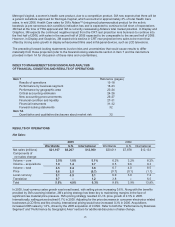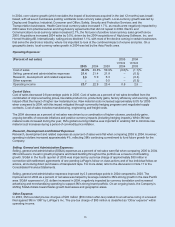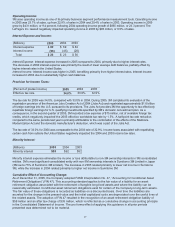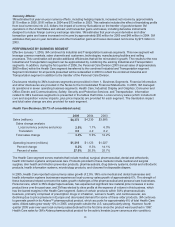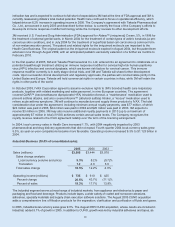3M 2005 Annual Report Download - page 51
Download and view the complete annual report
Please find page 51 of the 2005 3M annual report below. You can navigate through the pages in the report by either clicking on the pages listed below, or by using the keyword search tool below to find specific information within the annual report.
25
The Company believes its most critical accounting estimates relate to legal proceedings, the Company’s pension and
postretirement obligations, and potential asset impairment issues. Senior management has discussed the
development, selection and disclosure of its critical accounting estimates with the Audit Committee of 3M’s Board of
Directors.
Legal Proceedings:
The categories of claims for which the Company has estimated its probable liability, the amount of its liability
accruals, and the estimates of its related insurance receivables are critical accounting estimates related to legal
proceedings. Please refer to the section entitled “Accrued Liabilities and Insurance Receivables Related to Legal
Proceedings” (contained in “Legal Proceedings” in Note 11 to the Consolidated Financial Statements) for additional
information about such estimates.
Pension and Postretirement Obligations:
3M has various company-sponsored retirement plans covering substantially all U.S. employees and many
employees outside the United States. The Company accounts for its defined benefit pension and postretirement
health care and life insurance benefit plans in accordance with Statement of Financial Accounting Standards
(SFAS) No. 87, “Employers' Accounting for Pensions” and SFAS No. 106, “Employer’s Accounting for
Postretirement Benefits Other than Pensions”, which require that amounts recognized in financial statements be
determined on an actuarial basis. Pension benefits associated with these plans are generally based primarily on
each participant’s years of service, compensation, and age at retirement or termination. Two critical assumptions,
the discount rate and the expected return on plan assets, are important elements of expense and liability
measurement. The assumed health care trend rate is the most significant postretirement health care assumption.
See Note 10 to the Consolidated Financial Statements for additional discussion of actuarial assumptions used in
determining pension and postretirement health care liabilities and expenses.
The Company determines the discount rate used to measure plan liabilities as of the December 31 measurement
date for the U.S. pension and postretirement benefit plans. The discount rate reflects the current rate at which the
associated liabilities could be effectively settled at the end of the year. In estimating this rate, the Company looks
at rates of return on fixed-income investments of similar duration to the liabilities in the plan that receive high,
investment grade ratings by recognized ratings agencies. Using these methodologies, the Company determined a
discount rate of 5.50% to be appropriate as of December 31, 2005, which is a reduction of 0.25 percentage points
from the rate used as of December 31, 2004.
As of December 31, 2005, the Company converted to the RP (Retirement Plans) 2000 Mortality Table for
calculating the year-end 2005 U.S. pension and postretirement obligations and 2006 expense. The impact of this
change increased the year-end 2005 U.S. Projected Benefit Obligations for pension by $385 million, the year-end
2005 U.S. Accumulated Benefit Obligations for pension by $349 million and the 2005 U.S. Accumulated
Postretirement Benefit Obligation by $93 million. This change will also increase pension expenses for 2006 by
$64 million and postretirement expenses by $17 million.
A significant element in determining the Company's pension expense in accordance with SFAS No. 87 is the
expected return on plan assets, which is based on historical results for similar allocations among asset classes.
For the U.S. pension plan, the Company’s assumption for the expected return on plan assets was 8.75% for 2005
and will remain at 8.75% for 2006. Refer to Note 10 to the Consolidated Financial Statements for information on
how this rate is determined.
The difference between the expected return and the actual return on plan assets is deferred and, under certain
circumstances, amortized over future years of service. Therefore, the net deferral of past asset gains (losses)
ultimately affects future pension expense. This is also true of changes to actuarial assumptions. As of December
31, 2005, the Company had net unrecognized pension actuarial losses of $2.676 billion and $954 million for the
U.S. and International pension benefit plans, respectively, and $1.005 billion for the postretirement health care and
life insurance benefit plan. These amounts represent potential future pension and postretirement expenses that
would be amortized over average future service periods. The average remaining service periods for U.S. and
International pension plans and the postretirement plans are 10.2 years, 14.1 years and 10.0 years, respectively.
For the year ended December 31, 2005, the Company recognized total consolidated pre-tax pension expense
(after settlements, curtailments and special termination benefits) of $331 million, up from $325 million in 2004.
Pension expense (before settlements, curtailments and special termination benefits) is anticipated to decrease to
approximately $300 million in 2006. For the pension plans, holding all other factors constant, an
increase/decrease in the expected long-term rate of return on plan assets by 0.25 percentage points would


